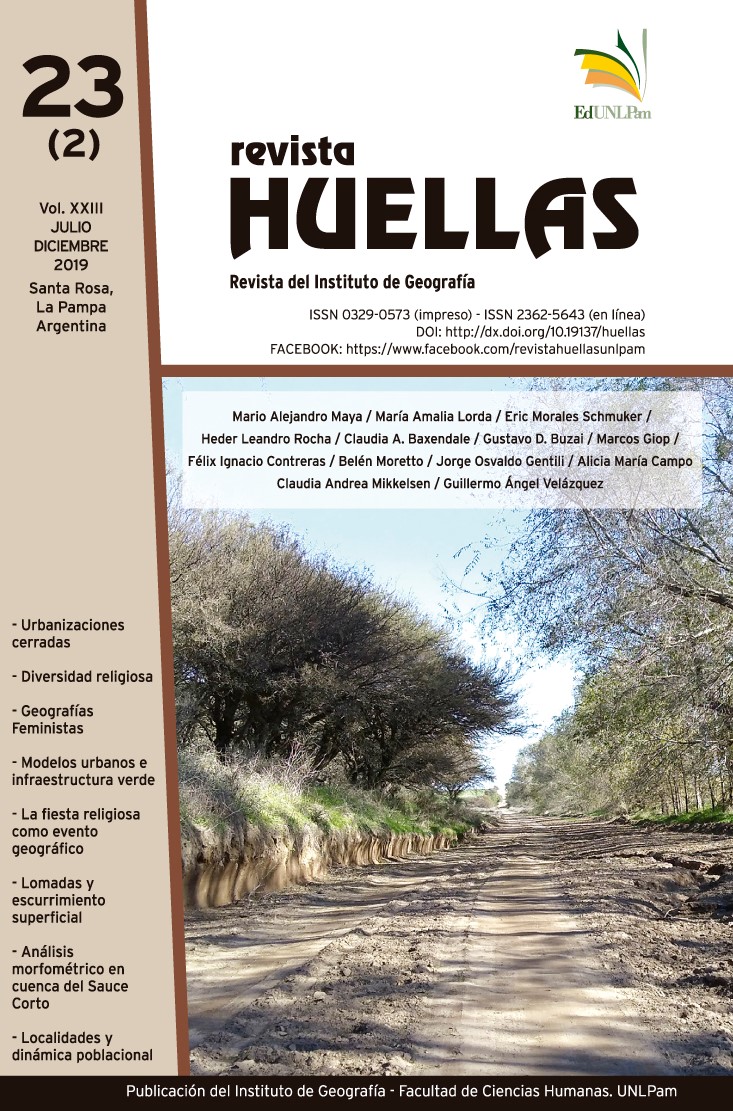"Burning the Judas": the fete as a geographical event
Keywords:
Fete, culture, stage, territory, Colonial Easter.Abstract
In the city of Luján, daily spatiality is built with great influence from the religious sphere. The city itself could be considered as the main seat of the Marian Catholic cult nationwide and visitors exceeding one million people annually is a clear evidence of this fact. Although it is not a practice with current origins (the first manifestations in Lujan are recorded in the colonial period) the fete of the Burning of Judas has experienced in recent years a new series of modifications around the morphology of the celebrations. During the first decade of the current century, the municipal government implemented a series of devices aiming at institutionalizing this holiday in order to include it in Luján “tourist agenda”. This situation opened a new space for disputes over the festivity, which is now formally known as the “Colonial Easter”. From a Cultural Geography perspective, this article proposes to carry out a theoretical discussion about the main conceptualizations thought as tools for a critical approach to the festive stages. The analytical categories of scenario, territoriality, fete, among others, are some of the concepts considered nodal to carry out the research.
Downloads
References
Auge, M. (1992). “Non-lieux. Introduction á une anthropologie de la surmodenité”, recuperado de :http://designblog.uniandes.edu.co/blogs/dise2609/files/2009/03/marc-auge-los-no-lugares.pdf
Christlieb, F. (2006). “Geografía Cultural” en Hiernaux y Lindón, Tratado de Geografía Humana. Pp. 220 a 253, Editorial Anthropos, México.
Claval, P. (1999). “Los fundamentos actuales de la geografía cultural”, Doc. Université de Paris-Sorbonne. Laboratoire Espace et Cultures 191, pp. 25-40, Paris.
Claval, P. (2001). Champ et perspectives de la géograpiheculturellle dix ans après Geographieetb Cultures, N° 40, Paris.
Claval, P. (2002). “El enfoque cultural y las concepciones geográficas del espacio” en Boletín de la A.G.E, ISSN 0212-9426, ISSN-e 2605-3322, N.º, Pp. 21-39, España.
Claval, P. (2014) .A festa religiosa, en Ateliê Geografico, vol. 8, Nº 1, pp. 6-29.
Coronel, D. (2017). Fiestas populares en el Conurbano Bonaerense: apropiaciones temporarias y disruptivas del espacio público en la ciudad de Berazategui desde la Muestra Anual Educativa (MAE), Tesis de licenciatura, Universidad Nacional del Centro de la Provincia de Buenos Aires, Buenos Aires.
Cosgrove, D. (2002). Observando la naturaleza: el paisaje y el sentido europeo de la vista en Boletín de la A.G.E, N° 34.
Di meo, G. (2001). La géographie en fêtes, OPHRYS, Paris.
Fradkin, R. (2000). Historia, memoria y tradición: la fiesta de la quema del Judas en Luján. Colección de cuadernos de trabajo, Departamento de Sociales, UNLu, Luján.
Luna García, A. (1999). ¿Qué hay de nuevo en la nueva geografía cultural?”, Doc. Anàl. Geogr. 34, 69-80, pp. 25-27, Barcelona.
Lindón, A. (2007). Los imaginarios urbanos y el constructivismo geográfico: los hologramas espaciales. En Revista Eure, Vol. 23, Nº99, Pontificia Universidad Católica de Chile, agosto de 2007, pp. 31-46, Santiago de Chile.
Lindón, A. (2008). De las geografías constructivistas a las narrativas de vida espaciales como metodologías geográficas cualitativas. En, Revista da ANPEGE, Vol. 4, Pp. 7-26, Porto Alegre.
Lindón, A. y Hiernaux, D. (2010). Los giros de la geografía humana –desafíos y horizontes-, Anthropos, México.
Lefebvre, H. (1991). [Original de 1974]. “The production of space”, Blackwell, Cambridge.
Lobato Corrêa, R. (2011). “Las formas simbólicas espaciales y la política”. En, Zusman, P.; Haesbaert, R.; Castro, H. y Adamo, S. (eds.) Geografías culturales. Aproximaciones, intersecciones y desafíos. Editorial de la Facultad de Filosofía y Letras de la UBA. Buenos Aires.
Eliade, M. (1956). The sacred and profane: the nature of religion. San Diego: Harcourt Brace, Jovanovich.
Massey, D. (1984). Geography matters: introduction, Cambridge University Press, Cambridge.
Schultz, U. (1993). “La fiesta. Una historia cultural desde la antigüedad hasta nuestros días”, Alianza, Madrid.
Unwin, T. (1992). El lugar de la geografía, Cátedra, Madrid.
Wagner, P. (2002). Cultura y geografía: un ensayo reflexivo en Boletín de la A.G.E, 34, pp. 41-50.
Zusman, P. y Haesbert, R. (2011). Geografías Culturales Aproximaciones, intersecciones y desafíos: introducción, Buenos Aires, Editorial de la Facultad de Filosofía y Letras, Universidad de Buenos Aires.






.png)












3.jpg)


